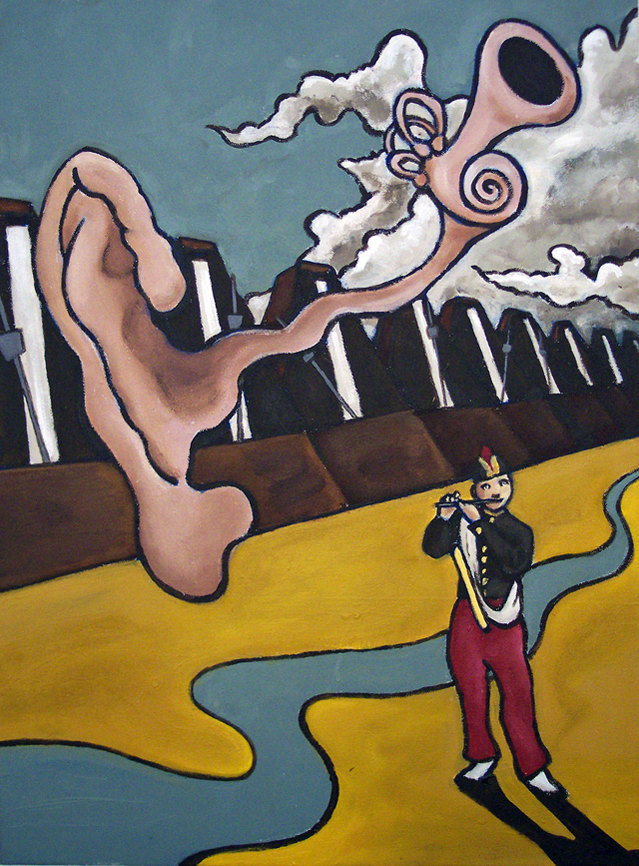10/11/09 – The Surreal Life
Back to Wind Orchestra – Past Concerts
Dr. Kevin Sedatole
guest conductor
Entry March of the Boyars
by Johan Halvorsen, arr. Frederick Fennell
The Girl with the Flaxen Hair
by Claude Debussy, arr. Michael Brand
Illyrian Dances
by Guy Woolfenden
1 – Aubade
2 – Gigue
3 – Rondeau
Wild Nights!
by Frank Ticheli
Gandalf, the Wizard from “Symphony No. 1”
by Johan de Meij
Sanctuary
by Frank Ticheli
Give Us This Day
by David Maslanka

The Surreal Life 10/11/09
From the 10th through the 17th century, the Boyars were the highest ranking members of the Bulgarian, Romanian, Russian, and Ukrainian aristocracy, second only to the ruling princes. Johan Halvorsen’s Entry March of the Boyars depicts the ceremonial entrance of these aristocrats in a theatrical setting. The march did not receive national recognition until Grieg, whose niece was Halvorsen’s wife, made a piano arrangement in 1898.
Claude Debussy’s first book of Preludes (1910), twelve in total, proved to be his most successful work for piano. Replete with rich, unusual and daring harmonies, they include the popular La Fille aux Cheveux de Lin (The Girl with the Flaxen Hair) and La Cathédrale Engloutie (The Engulfed Cathedral). Debussy wanted people to respond intuitively to these pieces and so he placed the titles at the end of each one in the hope that listeners would not make stereotype images as they listened. The title La Fille aux Cheveux de Lin comes from a poem that Debussy was fond of, which tells of a young Scots girl in the early morning sunshine.
Some of the thematic material for the suite of three Illyrian Dances is adapted from music originally written for the Royal Shakespeare Company. The precise location of Illyria was not important to Shakespeare; what excited him was the resonance of the word itself and the romance of all far away, make-believe places. Illyria is “Never Never Land,” and Guy Woolfenden was intrigued with the idea of inventing dances for such a place.
Wild Nights! is a joyous musical journey inspired by Emily Dickinson’s poem:
Wild Nights! Wild Nights!
Were I with thee,
Wild Nights should be
Our Luxury!
Futile the winds
To a heart in port, —
Done with the compass,
Done with the chart.
Rowing in Eden!
Ah! the sea!
Might I but moor
To-night in Thee!
In setting this wonderfully sensuous poem to music, Frank Ticheli focused on its sense of freedom and ecstatic joy. Throughout the piece, even during its darker middle section, the music is mercurial, impetuous, and optimistic. Unexpected events come and go, lending spontaneity, freedom, and a devil-may-care swagger.
Johan de Meij’s first symphony, The Lord of the Rings, is based on the trilogy of that name by J. R. R. Tolkein, first published in 1955. Tolkein made up the story of the hobbit Bilbo Baggins, who went with the wizard Gandalf and thirteen dwarves to steal the treasure of the dragon Smaug, as a bedtime story for his children. In essence a story of the ancient battle between light and darkness, it has been embraced by children and adults who fell in love with the hobbits, those little people with big, hairy feet and a passion for good food, pipe smoking, and comfort. The symphony, composed in 1988, consists of five movements, each illustrating a personage or an important episode from the book. The opening movement, Gandalf, is a musical portrait of the wise and noble wizard and his great steed Shadowfax.
Sanctuary was composed for conductor H. Robert Reynolds and received its 2005 premiere performance by the University of Michigan Symphony Band, which he conducted for 26 years. As a personal tribute to Mr. Reynolds, who was a horn player in his earlier days, Frank Ticheli chose the solo horn to be the work’s main musical messenger. The opening prologue grows out of a set of pitches that were derived from the letter of his first name (Harrah). The word “sanctuary” conjures a rich array of images. It can imply a place of solitude, comfort, rest, prayer, protection. It can suggest a place that is strong and imposing or one that is very small and private. All of these images are suggested at one point or another in the music.
The two-movement symphony for wind ensemble, Give Us This Day, was originally inspired by the writings of Vietnamese Buddhist monk, Thich Nhat Hanh. Hanh wrote “The future of our planet is only possible if individuals become deeply mindful of themselves; deeply connected to who they really are.” Through his music, David Maslanka connects Hanh’s idea with the need for a more peaceful world. This powerful symphony closes with a modal setting of choral melody “Vater Unser in Himmelreich,” known in English as “Our Father in Heaven,” from the four-part chorales of Johann Sebastian Bach.